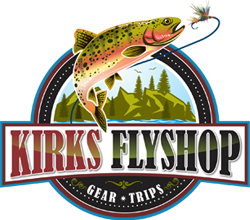Mastering Trout Fishing in the Winter: 5 Essential Techniques
As winter casts its icy veil over rivers and streams, dedicated anglers know that the pursuit of trout doesn’t hibernate and trout fishing in the winter can be exceptionally good. Winter fly fishing for trout presents unique challenges and rewards, requiring a strategic approach to entice these cold-water inhabitants. While most people hang up their fly rods and waders for the season, trout fishing in the winter can provide some of the best angling of the year. The trout have been rested, they haven’t seen as many flies, and the bigger ones can be fooled. It’s one of our favorite times to fly fish for trout!

Here are five proven techniques and tips to enhance your experience of trout fishing in the winter:
1. Choose the Right Flies
Trout in winter are selective feeders, making fly selection critical. Opt for midge patterns, stoneflies, and aquatic invertebrates. Small nymphs and emergers, such as Zebra Midges and RS2s, often prove effective on our local waters like the Big Thompson River. When in doubt, don’t be afraid to fish a worm pattern like a San Juan Worm or a Squirmy Worm.
Additionally, consider using streamers in darker colors to mimic the slower-moving prey in cold waters. Woolly Buggers, Sparkle Minnows, and larger articulated flies can do the trick.
2. Fish Slow and Deep
Trout in winter are lethargic, and their metabolism slows down. To maximize your chances while trout fishing in the winter, slow down your presentation and target deeper pools and runs where trout seek refuge from the cold currents. While the shallow riffles that we love to fish in the summer months are tempting, most trout will be in the most prominent holes where they are able to relax and rest. If you choose to fish with streamers, using sinking lines or adding weight to your leader to get your flies to the desired depth can be productive.
3. Mindful Approach to Water Temperature
Understanding the impact of water temperature is crucial in winter trout fishing. Focus on areas with consistent temperatures, such as tailwaters below dams, where water remains relatively warmer. Trout are more likely to be active in these zones, increasing your chances of a successful catch. If you’re into Colorado fly fishing, try the Big Thompson River or the North Platte in Cheesman Canyon.
4. Employ Nymphing Techniques
Nymphing is a go-to method in winter, as it effectively imitates the subsurface food sources trout target during the colder months. Utilize indicators to detect subtle takes, and experiment with various nymphing rigs to find the setup that works best in the specific conditions you encounter. As we say in the guiding business, “sets are free”. If your strike indicator moves in the slightest, set high and strong. While trout fishing in the winter, the bites can be subtle and hard to detect so be ready.
5. Dress for Success
Winter fly fishing for trout demands proper attire for both comfort and safety. Dress in layers to regulate body temperature, and invest in quality thermal baselayers and gloves to protect against the biting cold. Our typical under-wader outfit consists of long underwear, insulated puffy pants, merino top baselayer, fleece, insulated puffy jacket, and a beanie cap to keep our noggins warm. In addition to warm clothing, we bring handwarmers for inside our wader pockets and a micro-fiber towel to dry our hands after releasing a fish.
While trout fishing in the winter isn’t for the faint of heart, we love the solitude and the opportunity to shake off the winter blues. So, bundle up, pick the right flies, and venture into the tranquil beauty of winter waters to pursue these elusive cold-water gems.
Want to experience winter fly fishing in Estes Park for yourself? Book one of our Estes Park fly fishing guides for a day on the Big Thompson River. We guarantee that you’ll learn something new about our local waters and even better, you’ll catch a few fish while you’re at it.

